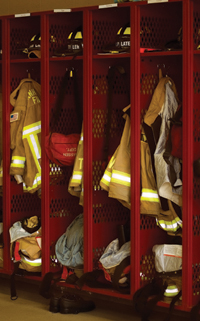
Features
Leadership
Step by step
We all know the saying about calling a spade a spade. Well, sometimes we need to take an inventory of our leadership style and see if it really fits with the department. We may think we are making the right moves, saying the right things and doing what has to be done but are we really leading?
November 6, 2009
By Les Karpluk
We all know the saying about calling a spade a spade. Well, sometimes we need to take an inventory of our leadership style and see if it really fits with the department. We may think we are making the right moves, saying the right things and doing what has to be done but are we really leading? This is a tough question and it requires deep reflection before it can be answered honestly.
The Japanese have a term for this deep reflection called hansei. In The Elegant Solution: Toyota’s Formula for Mastering Innovation, author Mathew May describes hansei as the rigorous review conducted after an action, a sobering reality check that is essential for learning. Understanding who we are, what we do, and why our departments are servicing our communities is absolutely essential before we can take our departments to the next level. Ah, the next level; that elusive goal that keeps moving and forces us to change our game plan more times than we would like to admit.

|
|
| Today’s progressive fire chiefs understand the word collaboration and work with staff to gain a commitment for the mission, vision and values of the department.
|
Yes, hansei must be practised by those in the department who have the consuming desire to change the future. Hansei must be practised by those who are confident enough to look deep within themselves. Hansei must be practised by those who hold the responsibility to take the department to the next level. Yes, hansei is necessary for personal and departmental growth. Practising hansei is only the beginning of taking our departments to the future land. This may sound a bit off the wall, but I am willing to learn something from the management philosophies of a company that Fortune magazine stated in February 2006 was the world’s finest manufacturer and a truly great innovator.
■ Organizational change
Planning organizational change in the fire department is complex and any move to change the norm or the culture of the department will more than likely be met with resistance. However, it may not be as doom as gloom as it first appears. I recently had the opportunity to speak at the British Columbia Fire Training Officers Association conference in Maple Ridge and delivered a presentation detailing leadership stages that can help leaders take fire departments to new frontiers.
Like any other fire chief it is my desire to lay out the future of the department before someone else does. Of course, this means that the chief and his staff must believe in the stages before any growth can occur, and, more importantly, must believe in the direction of the promised future state.
First and foremost, the chief must reframe the future of the department. The fire chief must look for new possibilities and rethink relationships inside and outside the department. This means looking for new ways to deliver our services more effectively and efficiently (sound business sense) and seeking alternative services for the community. For example, departments can provide mentoring programs through which firefighters are partnered with youth facing challenging circumstances in their lives. Or, departments might spearhead anti-graffiti campaigns. Filling gaps in the community fosters relationships outside of the department. We need to look for those areas in our communities that require strong leadership and then step up to the plate. Those kinds of actions win friends and votes.
The chief must champion commitment from staff in order to be an effective leader. Committed followers are not sheep that do not have a voice in the department. Today’s progressive fire chief understands the word collaboration and works with staff to gain a commitment for the mission, vision and values of the department. Be careful though, as anyone can write mission, vision and value statements for the department. You cannot fake commitment and staff need to see the mission, vision and values exercised daily otherwise they lose their effectiveness and become sterile.
 |
|
| Chiefs who want to lead their departments into the future need to reflect on their motives and understand who and what they are.
|
The art of teaching and coaching must also occur daily so staff can develop and grow. Failure to teach and coach our staff will force the chief to deal with their problems. Teaching and coaching for building competencies and staff confidence is crucial for building organizational competence. Why organizational competence? Because we want to be strong as an organization so we are able to withstand those bumps in the road. Ensuring a strong organizational competence builds a solid foundation for department succession planning and career success. Sounds like a good enough reason for me.
Understanding the difference between the team and teamwork is fundamental for growth of the department. Having a team and working together are two different things and the fire chief must identify expectations for all positions in the department. This may sound elementary, but if expectations are not laid out and department values are not clear, then how can staff achieve success in their careers? Without expectations we create an environment where the act of reporting for duty is more a burden than delight – not something we can use to build the future.
The reality is that the fire chief will be required to make easy and difficult decisions. The easy decisions are those no-brainers while the difficult decisions often require significant emotional energy and result in a win-lose situation with staff. Some staff will understand the rationale for those difficult decisions while others will point fingers and judge.
Sometimes we have to call a spade a spade. There are those who will never see the vision (wanderers), those who see the vision but ignore it (followers), those who see the vision and choose to pursue it (achievers) and those who see the vision, pursue it, and help others see it (leaders). If we are going to lead our departments into the future we need to reflect on our motives and understand who and what we are. We need to believe in our people and work diligently with our achievers and leaders; doing this will bring many followers onside and into the reality stage. This is critical for leading the department into the future.
I presented a quote at the opening ceremonies of the British Columbia Fire Training Officers Association Conference in May, and it is worth repeating here. Education advocate Emery Stoops stated, “Leadership is complicated. It is intellectual; it is emotional, and it is physical. It is inherited and it is learned. It is the summation of the total man which must square with the myriad desires of the group.” Our profession deserves nothing less from us, and I was proud to be around so many professionals during my time at the Maple Ridge conference.
Les Karpluk CFO, BAppBUS: ES is fire chief of Prince Albert Fire and Emergency Service in Saskatchewan. He is a graduate of the certificate in fire service leadership and fire service administration programs at Dalhousie University and graduate of the Bachelor of Applied Business: Emergency Services from Lakeland College. Contact him at l.karpluk@sasktel.net.
Print this page